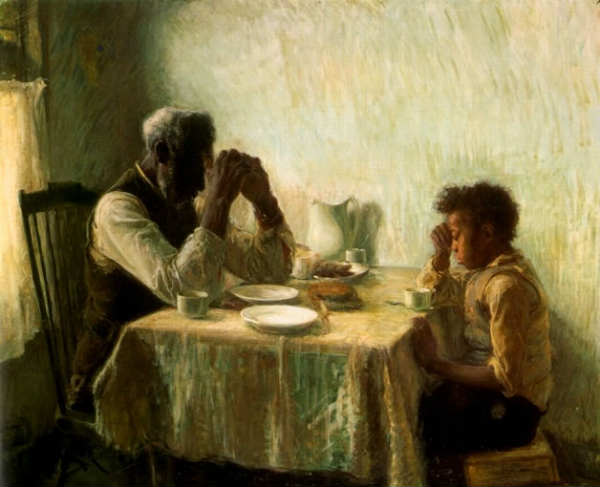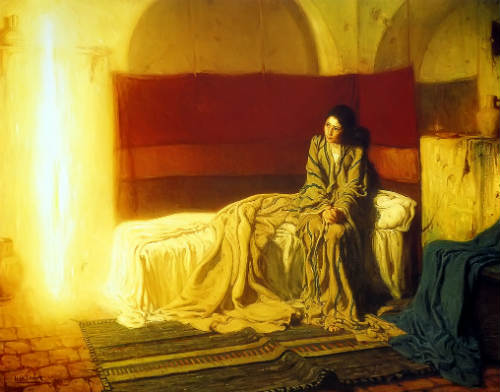Search:: Artists Alphabetically Artists by Country Artists by Century Artists by Movement
Henry Ossawa Tanner
1859-1937
One of the Greatest Painters Of All Time
Education - studied under Thomas Eakins at the Pennsylvania Academy of the Fine Arts in Philadelphia

The Thankful Poor c.1894 by Henry O. Tanner one of the greatest paintings of all time
Henry
O. Tanner Biography
Henry Tanner was born in Pittsburgh, Pennsylvania. He cam from a large,
loving family. His father Benjamin Tucker Tanner was was a prominent
minister as well as a writer. Tanner was racially mixed and had to put
up with racism during his fine art education and budding career while
in the United States.
He fell in love with the city of Paris and permantly made the city his home. He may have been drawn to religious paintings because of his father career. Henry Tanner asserted "It has very often seemed to me that many painters of religious subjects (in our time) seem to forget that their pictures should be as much works of art (regardless of the subject) as are other paintings with less holy subjects. To suppose that the fact of the religious painter having a more elevated subject than his brother artist makes it unnecessary for him to consider his picture as an artistic production, or that he can be less thoughtful about a color harmony, for instance, than he who selects any other subject, simply proves that he is less of an artist than he who gives the subject his best attention."
According
to Benjamin
Brawle, Henry Tanners's biographer,
"Mr. Tanner's later life has been spent in Paris, with trips to the Far
East, to Palestine, to Egypt, to Algiers, and Morocco. Some years ago
he joined the colony of artists at Trepied, where he has built a
commodious home and studio. Miss MacChesney has described this for us:
"His studio is an ideal workroom, being high-ceilinged, spacious, and
having the least possible furniture, utterly free from masses of
useless studio stuff and paraphernalia. The walls are of a light gray,
and at one end hangs a fine tapestry. Oriental carved wooden screens
are at the doors and windows. Leading out of it is a small room having
a domed ceiling and picturesque high windows. In this simply furnished
room he often poses his models, painting himself in the large studio,
the sliding door between being a small one. He can often make use of
lamplight effects, the daylight in the larger room not interfering."
Within recent years the artist has kept pace with some of the newer
schools by brilliant experimentation in color and composition.
Moonlight scenes appeal to him most. He seldom paints other than
biblical subjects, except perhaps a portrait such as that of the
Khedive or Rabbi Wise. A landscape may attract him, but it is sure to
be idealized. He is thoroughly romantic in tone, and in spirit, if not
in technique, there is much to connect him with Holman Hunt, the
Pre-Raphaelite painter."
.

The Annunciation c.1896 by Henry Tanner
Henry Tanner once stated "I have taken the tradition that Christ never spent a day in Jerusalem, but at the close of day went to Bethany, returning to the city of strife in the morning." Of "A Flight into Egypt" he says: "Never shall I forget the magnificence of two Persian Jews that I once saw at Rachel's Tomb; what a magnificent 'Abraham' either one of them would have made! Nor do I forget a ride one stormy Christmas night to Bethlehem. Dark clouds swept the moonlit skies and it took little imagination to close one's eyes to the flight of time and see in those hurrying travelers the crowds that hurried Bethlehemward on that memorable night of the Nativity, or to transpose the scene and see in each hurrying group 'A Flight into Egypt.'"
If you feel you have worthwhile information you would like to contribute we would love to hear from you. We collect essential biographical information and artist quotes from folks all over the globe and appreciate your participation. When submitting please, if possible, site the source and provide English translation. Email to millardmulch@gmail.com
☼☼☼☼☼
© HistoryofPainters.com If you like this page and wish to share it, you are welcome to link to it, with our thanks. updated 4/2017